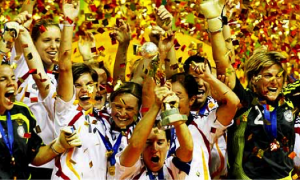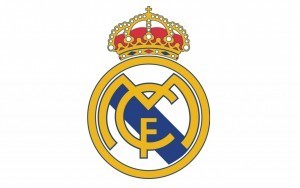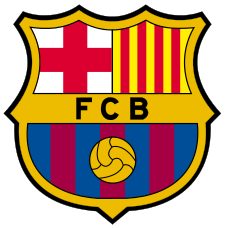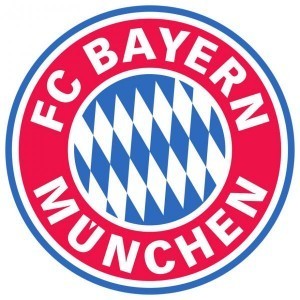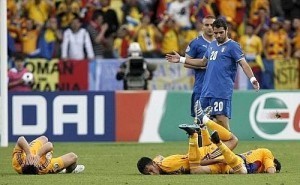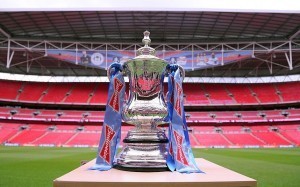Laurent Dubois's Blog, page 63
April 30, 2015
USWNT Shows Their Support for Bruce Jenner
Anyone who follows sports, Diane Sawyer, or the Kardashians knows that this week, Bruce Jenner officially announced that he is a transgender woman. In a two hour-long interview with Diane Sawyer, Jenner explained that this is an issue he’s been dealing with for all of his life (and that he would prefer to be called he for the time being).
If there were any concerns about support for the former gold-medalist, however, members of the US Women’s National Team seem to be trying to alleviate them. Since the interview earlier this week, there has been an outpouring of support from prominent members of the national team. One of the most notable posts came from Megan Rapinoe, an active member of the LGBTQ community. Rapinoe is a member of Athlete Allies, an organization which encourages inclusion of LGBTQ athletes. Her response to Jenner’s coming out was simple: “You go girl.”
Rapinoe wasn’t alone in her kind words, however. Teammate Sydney Leroux took to Twitter to voice similar sentiments, telling Jenner, “The courage you have to be who you are is inspiring.” She added a photo of herself, Jenner, and teammates after winning her own Olympic gold medal. We’ve discussed time and time again the extent to which being and open member of the LGBTQ community affects both male and female athletes. We’ve also discussed how rarely athletes in the US make political statements. This week, those two issues came together when the members of Team USA made a decision to support one of their fellow Olympians.
April 29, 2015
Headgear is Ok, but a Hijab Isn’t?
A while back we were asked to read a piece “The Hijab on the Pitch” by our very own Professor Dubois. This piece introduced me to some information and perceptions some people have on the hijab. Introduced with a fierce image of the Iranian Women’s national team, I was in awe when I read that the French Federation banned the hijab during organized competitions. The idea that a certain group of people were having their culture outright disrespected didn’t complete surprise me given the current state of the world, but I did not expect such claims from France. As a Muslim, I felt ashamed that I had not followed this incident, that people I share a significant school of thought with are facing such apparent backlash. Is it not strange to anyone that makes these decisions that telling a woman to alter her form of dress is down right rude? Telling a woman to casually remove her hijab in a public setting is almost as bad as telling her to walk around naked. So banning the hijab in public places in France will force Muslim women who decide to wear the garment to stay at home, and I cannot wrap my head around the idea that a simple article of clothing is such an issue.
“I am not out to impress of fit in. I am in it to play. Hard.”
Yes there is a lot of controversy surrounding women in Islam and they suffer enough discrimination, why add more to it? This isn’t the first time that France has been openly against religious freedoms for Muslims. In 2009, a Muslim woman was asked to leave a public pool while on vacation because her burquini (a modest form of a bathing suit) was not allowed. The claims were that her form of dress was banned for “hygiene reasons.” While these women are trying to be progressive in their environment by breaking boundaries through the beautiful game, the institutions that are used to fostering progression are pushing them away. Who are these women supposed to turn to? Dr. Dubois makes a great point in his article where the idea of the hijab being a “safety hazard” is an extremely invalid argument given that several players sport headgear, long hair, and several other objects that can lead to injury. And for claims that women who wear hijab are being ‘oppressed’ by men are very false, and forcing a woman to remove her hijab in public is not liberating for her in any way. She wears it by choice, a choice that should be respected. Since when has impression of a people group gotten us anywhere good?
Dr. Dubois’s article led me to the famous soccer blog “Tales From a Hijabi Footballer.” This witty site shares insight on the struggles Shireen Ahmed faces as a female Muslim soccer player. While I unfortunately missed her visit to campus, her blog provides ample opportunities for people to learn about the hijab and what it’s like to wear one everyday. People who wear hijab already deal with more stares from people in one day than other people do in a week. I cannot emphasis enough or understand the amount of bravery that these women that play soccer with hijabs on all kinds of stages large and small possess. Ahmed’s sassy confidence and quick wit definitely inspires me to keep up with the growth of women wearing hijab on the soccer field. “I am not out to impress of fit in. I am in it to play. Hard.”
Soccer Violence Escalates with Economic Woes
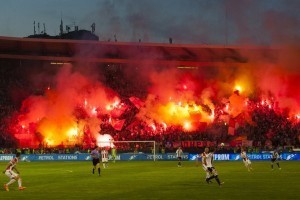
Outbreak in a Serbia soccer game (Photo by: WSJ)
On Saturday in Belgrade, Serbia, fans of the soccer team Red Star were very angry about being penned in at the stadium before a match against rival Partizan. This caused many of the fans to begin ripping out the hard plastic seats and hurling them at the police. Partizan fans rained dozens of flares on the police, which spewed smoke that covered the field and blinded the players. The game had to be suspended due to the unrest.
Soccer-related violence is not new in Europe, but recent figures have shown that the situation may be getting worse. This is partly exacerbated by the economic downturn that most of Europe has been experiencing. Driven by Europe’s economic struggles, there has been an accompanying rise in nationalism and racism.
Michel Platini, Europe’s top soccer official has said,
“In recent months we have all been struck by certain images that I thought were things of the past…a past where hooligans and all manner of fanatics called the shots in certain European stadiums.”
This has become the norm in Europe. In Spain, a 43-year-old fan died in a bloody brawl in November outside Madrid’s stadium. In Rome, Dutch fans ran through the city and damaged a 400 year old fountain. In Greece, soccer leagues had to be briefly suspended due to a series of violent outbreaks. In addition to these riots, racist incidents have also increased severely.
In Serbia, the government tried to adopt a strategy on sports violence in 2013, which included measures such as stronger bans on violent fans. But many sports experts say that clubs are entwined with crime and politics and cannot be reformed through better policing. It seems that these outbreaks have been strong integrated with the economic downfalls currently happening in Europe. While the government has condemned the violence as unacceptable and said that the country’s sports teams would be privatized, it will be incredibly tough to implement these changes.
Sources:
http://www.wsj.com/articles/soccer-vi...
http://www.wsj.com/articles/soccer-fa...
April 28, 2015
2007 Women’s World Cup in China
Host: China (for the second time)
Dates: September 10- September 30
Winner: Germany
Golden Ball Winner: Marta (Brazil)
Golden Shoe Winner: Marta (Brazil) with 7 goals
The German team celebrating their World Cup victory (Dowling)
Precedents
Since the FIFA Women’s World Cup only originated in 1991, the tournament was still evolving. As such, the 2007 World Cup (fifth Women’s World Cup in history) set new precedents for the tournament. For instance, this is the first Women’s World Cup where all teams were given monetary bonuses according to the last round they reached (2007 FIFA Women’s World Cup). The champions receive $1 million, runners-up receive $800,000, third place receives 650,000, fourth place receives 550,000, quarter-finalists receive 300,000, and first round exits receive 200,000 (2007 FIFA Women’s World Cup). For comparison, monetary bonuses in the FIFA Men’s World Cup range from all participating teams receiving at least $1 million to the champions receiving $30 million.
A second precedent is that this was the first year that the Union of European Football Associations (UEFA) used the FIFA Women’s World Cup as a qualifier for the Olympics, which occurs the year after each World Cup. The top three performing UEFA teams qualify for the Olympics (2007 FIFA Women’s World Cup).
As far as team precedents, Germany beat Argentina by an unprecedented 11-0, the largest score differential in the history of the World Cup. Additionally, Germany did not concede a goal the entire tournament, which is the first time this has happened in the history of the Men’s and Women’s World Cup ().
Location
China, the host of the first Women’s World Cup back in 1991, was originally slated to host the 2003 World Cup; however, FIFA was forced to move the 2003 tournament to the USA due to a Severe Acute Respiratory Syndrome (SARS) outbreak in China from late 2002 to mid-2003. By the time the 2007 World Cup rolled around, the Chinese Local Organizing Committee was ready to go all out for the tournament (
The tournament was played in five different cities: Wuhan, Shanghai, Hangzhou, Tianjin, and Chengdu. The stadium capacities ranged from 33,000 people in Shanghai’s “Hongkou Stadium” (on right) to 60,000 in Tianjin’s “Tianjin Olympic Centre Stadium. All but the Hongkou Stadium had been built within 10 years of the tournament. Additionally, aside from soccer matches for local Chinese soccer teams, the 2007 World Cup was by far the biggest event these stadiums were used for (Hongkou Football Stadium). There was a total of 1,190,971 viewers throughout the tournament and an average of 37,218 viewers at each game (2007 FIFA Women’s World Cup).
A year of firsts
Two legendary players starred in their national team debut on the 2007 World Cup pitch. One was Hope Solo, who started for the USA as goalkeeper at age 25, replacing veteran goalkeeper Briana Scurry. Additionally, Brazilian forward Marta, 21, began her successful career at the 2007 World Cup. Marta scored 7 goals in the tournament, earning both the Golden Shoe and Golden Ball awards in her World Cup debut. 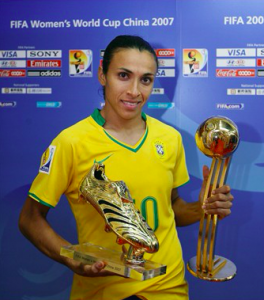
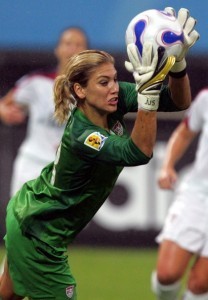 Left: U.S. goal keeper Hope Solo makes a save in their win against Sweden in the group stage of the 2007 World Cup (Martinez)
Left: U.S. goal keeper Hope Solo makes a save in their win against Sweden in the group stage of the 2007 World Cup (Martinez)
Right: Marta holds the Golden Ball and Shoe awards she received at the 2007 World Cup (redjiblog)
Controversy
Hope Solo had started in every match of the group stage as well as the first match against England in the knockout stage for the 2007 World Cup. However, head coach Greg Ryan opted to play veteran goalkeeper Briana Scurry over Solo in their semifinals game against Brazil. Ryan made this decision based on Scurry’s previous success against Brazil; she had played Brazil’s national team 12 times and won each game (“Goalie switch fails to work as USA falls to Brazil – USATODAY.com”). However Scurry had never faced 21-year-old Marta, who ended up winning the Golden Ball and Golden Shoe of the tournament. With Scurry in the goal, the U.S. lost 0-4, their worst loss in the Women’s National Team history, and ended the team’s 51-game winning streak (“Goalie switch fails to work as USA falls to Brazil – USATODAY.com”). In response to being benched, Solo said, “there’s no doubt in my mind I would have made those saves. And the fact of the matter is, it’s not 2004 anymore,” (Nye) referencing Scurry’s last major victory when the WNT won the 2004 Olympic games in Athens. Solo was suspended from the team; however, was returned to the team as starting goalkeeper just one year later in the 2008 Olympics (Nye).
and won each game (“Goalie switch fails to work as USA falls to Brazil – USATODAY.com”). However Scurry had never faced 21-year-old Marta, who ended up winning the Golden Ball and Golden Shoe of the tournament. With Scurry in the goal, the U.S. lost 0-4, their worst loss in the Women’s National Team history, and ended the team’s 51-game winning streak (“Goalie switch fails to work as USA falls to Brazil – USATODAY.com”). In response to being benched, Solo said, “there’s no doubt in my mind I would have made those saves. And the fact of the matter is, it’s not 2004 anymore,” (Nye) referencing Scurry’s last major victory when the WNT won the 2004 Olympic games in Athens. Solo was suspended from the team; however, was returned to the team as starting goalkeeper just one year later in the 2008 Olympics (Nye).
Affect on the 2008 Olympics
2007 was the first year that the FIFA Women’s World Cup was used as a qualifier for the Olympics. The top three European finishers qualify, which in 2007 were Germany, Brazil, and England. However since England competes as Great Britain (rather than England) in the Olympics, England was not given the third qualifying spot. Instead the next two top European teams, Sweden and Denmark, competed in a UEFA playoff game and the winner, Sweden, advanced to the 2008 Olympic games ().
The result of the Women’s soccer tournament in the Olympics varied only slightly from the FIFA World Cup. The top three teams were the same in both tournaments; however, the USA finished first, Brazil second, and Germany third in the Olympics just one year later. This could be due in part to the U.S. opting to start Hope Solo in goal rather than older veteran goalkeeper Briana Scurry as they had done in the World Cup ().
Group Stage
Group A: Germany, England, Japan, and Argentina
Germany, the number one seed in the tournament, annihilated the competition, winning their two games against Argentina (11-0) and Japan (2-0) and tying England after a scoreless match. As expected, Germany easily advanced to the knockout round. England was the other team to advance from group A, beating Argentina 6-1 and ending up with a second draw against Japan (2-2). Argentina, the lowest ranked team in the group, lost all three of their games, including a 1-0 loss against Japan (2007 FIFA Women’s World Cup).
Women’s World Cup 2007 Germany 11-0 Argentina highlight
Group B: USA, North Korea, Sweden, and Nigeria
Group B was an exact repeat of group A in the 2003 World Cup, but yielded a slightly different outcome. The group stage results of these four teams were very cut and dry in the previous World Cup, with USA winning all three games, Sweden winning two, North Korea winning one, and Nigeria losing all three. However the 2007 results involved some upsets. Rather than Sweden advancing to the knockout round, North Korea advanced alongside the USA. USA won their games against Sweden (2-0) and Nigeria (1-0) and tied North Korea 2-2. These games were much closer than the previous World Cup, where the USA had defeated Nigeria 5-0 (2007 FIFA Women’s World Cup).
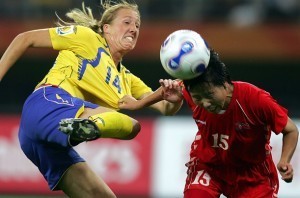 North Korean defender Sonu Kyong Sun heads the ball away from Sweden’s Sara Johansson as she takes a shot on goal during the Sweden vs North Korea game in the group stage (Baker).
North Korean defender Sonu Kyong Sun heads the ball away from Sweden’s Sara Johansson as she takes a shot on goal during the Sweden vs North Korea game in the group stage (Baker).
Group C: Norway, Australia, Canada, and Ghana
Norway finished at the top of group C, after crushing Ghana (7-2), defeating Canada by one (2-1), and tying Australia 1-1. Australia finished in second place with a 4-1 win over Ghana and a tie against Canada (2-2). Ghana finished last after losing all three of their games, including a 4-0 loss to Canada. These results were very predictable; Ghana was by far the lowest ranked team going into the 2007 World Cup, with a ranking of 47th in the world (The FIFA Women’s World Ranking)
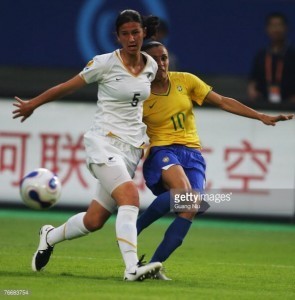 Group D: Brazil, China PR, Denmark, New Zealand
Group D: Brazil, China PR, Denmark, New Zealand
Brazil dominated Group D and advanced to the knockout stage without conceding a single goal. The Brazilians beat New Zealand 5-0, China PR 4-0, and Denmark 1-0. China also advanced to the knockout stage by beating Denmark 3-2 and New Zealand 2-0. Denmark finished third in the group after they beat New Zealand 2-0. New Zealand went scoreless for the entire competition. In the photo on the right, defender Abby Erceg (left) defends the ball from striker Marta in the Brazil vs. New Zealand game in the group stage (Niu)
Knockout Stage
Quarterfinals
Germany continued their domination with a 3-0 win against North Korea, Norway defeated China Pr 1-0, and the U.S. defeated England 3-0. The only match where the losing team managed to score a goal was Brazil vs Australia, where Brazil beat the Aussies 3-2. Ironically, Brazil had been one of two teams (the other team being Germany) to not concede a goal during the group stage.
Semifinals
In a series of uneventful matches where the losing team couldn’t even score a single goal, Germany defeated Norway 3-0 and Brazil beat the U.S. 4-0. These results were surprising, considering that in June 2007 (the most recent FIFA Women’s Rankings before the tournament) the USA was ranked 1st, Germany 2nd, Norway 4th, and Brazil 8th in the world (The FIFA Women’s World Ranking). However taken in the context of the games, these decisive wins were expected. Not a single goal was scored on Germany throughout the entire World Cup, due to the exceptional German Goalkeeper and “Best Goalkeeper Award” recipient for the tournament Nadine Angerer. Additionally, the rankings did not fully account for Brazilian striker Marta, who made her national debut on the Brazilian team at this tournament. Additionally, starting U.S. goalkeeper Hope Solo was benched for the Brazil vs USA game, which greatly hurt the team in retrospect. In the third place match, the U.S. defeated Norway 4-1.
Brazil Marta Amazing Goal vs USA (World Cup China)
Final
In an entertaining match, Germany defeated Brazil 2-0 to earn their second World Cup championship title. The match was scoreless until Germany scored their first goal just over halfway through the game. Brazil received a penalty kick near the 65-minute mark, but Germany’s goalkeeper Nadine Angerer deflected Marta’s shot. After that, Germany’s goal very late in the game cemented their victory. Germany’s success was due to a combination of top-notch goalkeeping by Angerer, as well as the German defense successfully keeping the ball away from the tournament’s top scorer: Marta. This was the first ever Women’s World Cup to be between a European and South American team, as well as the first time a South American team competed in the Final.
Final: Germany 2 Brazil 0- 2007 FIFA Women’s World Cup
Looking Ahead
Group B for the 2007 tournament was almost exactly the same as the 2015 tournament this summer, except Australia will be replacing North Korea (Verschueren). While many are calling the USA’s bracket the “group of death,” the USA finished at the top of the group back in 2007, and could definitely do so again. Although these teams have all changed since 2007, there’s a good chance that the results of the games this summer will be similar to past results. This group in 2007 was an exact repeat of a group in the 2003 tournament and the results were very similar.
Sources
Baker, Greg. “FIFA Women’s World Cup — China 2007 – Photo Essays.” Time. Time Inc. Web. 27 Apr. 2015. .
Dowling, Siobhan. “Women’s Football Is Still a Pauper’s Game, despite World Cup Success.” Theguardian. Guardian News and Media Limited, 15 July 2011. Web. 26 Apr. 2015. .
“FIFA Women’s World Cup China 2007.” FIFA.com. FIFA. Web. 26 Apr. 2015. .
“FIFA Women’s World Cup China PR 2007: One Year to Go.” FIFA.com. FIFA, 10 Sept. 2006. Web. 26 Apr. 2015..
“Football at the 2008 Olympics– Women’s Tournament.” Wikipedia. Wikipedia, 9 Jan. 2015. Web. 26 Apr. 2015. .
“Goalie Switch Fails to Work as USA Falls to Brazil – USATODAY.com.” Goalie Switch Fails to Work as USA Falls to Brazil – USATODAY.com. USA TODAY, 1 Jan. 2007. Web. 26 Apr. 2015. .
“Hongkou Football Stadium.” Wikipedia. Wikimedia Foundation, 30 Nov. 2014. Web. 26 Apr. 2015. .
Martinez, Ronald. “Hope Photostream.” Zimbio. 11 Sept. 2007. Web. 26 Apr. 2015. .
Niu, Guang. “Abby Erceg of New Zealand and Marta of Brazil Fight for the Ball…” Getty Images. Getty Images. Web. 29 Apr. 2015. .
Nye, James. “Hope Solo Reveals How She Was Kicked off U.S. Team in 2007 after Being Accused of ‘treason'” Mail Online. Associated Newspapers, 14 Aug. 2012. Web. 26 Apr. 2015. .
Redjiblog. “Can Marta Lead Brazil to World Cup Glory?” Lako A Football Aficionados Blog. 1 July 2011. Web. 26 Apr. 2015. .
“The FIFA Women’s World Ranking – FIFA.com.” FIFA.com. FIFA. Web. 27 Apr. 2015. .
Turner, Georgina. “The Joy of Six: Women’s Football.” Theguardian. Guardian News and Media Limited, 24 June 2011. Web. 26 Apr. 2015. .
Verschueren, Gianni. “USA Draw Group of Death in World Cup.” Bleacher Report. 6 Dec. 2014. Web. 26 Apr. 2015. .
“2007 FIFA Women’s World Cup.” Wikipedia. Wikimedia Foundation, 6 Mar. 2015. Web. 26 Apr. 2015. .
April 27, 2015
Histoire Court des Equipes dans le semi de Ligue des Champions

L’image au dessus (que vient de graphiste Emilio Sansolini) des maillots vielles de ces équipes dans les semis de ligue des champions me fait penser de l’histoire de chaque équipe, quand ils portaient ces maillots ici. Pour moi, ces équipes (avec quelques plus en Angleterre) sont les gardiens de football – les équipes avec le plus de suces et les meilleures histoires – sont les équipes plus fameux dans le monde maintenant. Mais, qui, de ces équipes, a le plus de suces? Voici est un histoire des statisques pour chaque équipe, et nous pouvons voire qui est le vrai équipe avec le plus célèbre histoire!
Barcelona [1]
Location: Barcelona, Catalonia, Espagne
Fondation: 29 Novembre 1899
Stade: Camp Nou
Victoires: 22 Championats de La Liga, 26 Copa del Rey, 11 Supercopa de Espana, 3 Copa Eva Duarte, 2 Copa de La Liga, 4 Ligue De Champions, 4 UEFA Super Cup, 2 Coupe du Monde Club
Fait amusante: L’équipe n’avais jamais été relégué a deuxième ligue en Espagne.
Juventus [2]
Location: Turin, Italie
Fondation: 1897
Stade: Stade Juventus
Victoires: 28 Championnats de Seria A, 9 Coppa Italia, 2 Ligue des Champions, 2 UEFA Super Cup
Fait Amusante: L’équipe était fondée par une groupe d’étudiants
Real Madrid [3]
Location: Madrid, Espagne
Fondation: 1902
Stade: Santiago Bernabeu
Victoires: 31 Championnats de La Liga, 18 Copa del Rey, 2 Coupes UEFA, 10 Ligue des Champions, 8 Supercopa de Espana, 1 Copa Eva Duarte, 1 Copa de la Liga
Fait amusante: Real Madrid était une des équipes qui étaient les fondateurs de FIFA
Bayern Munich [4]
Location: Munich, Allemagne
Fondation: 1900
Stade: Allianz Arena
Victoires: 24 Bundesliga, 17 Coupe DFB d’Allemagne, 5 Supercoupe Allemagne, 6 Coupe de Ligue, 5 Ligues des Champions, 1 Coupe de UEFA, 1 UEFA Winner’s Cup, 1 Coupe du Monde Club, 1 Supercoupe
Fait amusante: L’equipe est entré a irrelevance pendant le Deuxième Guerre Mondiale.
Alors, qu’est-ce que vous pensez? Qui est l’équipe avec l’histoire plus impressionnante? Pour moi, c’est Real, mais j’espère de voire ton commentaires dessous.
[1] http://en.wikipedia.org/wiki/FC_Barcelona
[2] http://www.espnfc.us/story/841135/a-brief-history-of-juventus
[3] http://ibnlive.in.com/worldoffootball/club/facts/real-madrid.html
[4] http://fcb-erlebniswelt.de/en/history/honours/index.php/
April 26, 2015
Pia Sundhage – Sweden’s next men’s football coach?

Pia Sundhage, image from FIFA.com
As I’ve been reading through multiple articles surrounding the build-up to the 2015 Women’s World Cup for the Swedish team, one name has consistently come up: Pia Sundhage. The former coach of the US women’s national team, and now the current coach of the Swedish women’s national team, is revered by both players and fans. Her quirky and open personality has often lead her to make some of the most pertinent and truthful comments in response to many critics of the women’s game.
What I found to be most interesting is that in the past 2 years there has been much talk about her being considered for the position of coach for either the men’s national team (for Sweden), or for one of the top teams in the Swedish league, Kalmar. What a remarkable moment that would be! Tor Krusell comments on this:
“Measured in terms of competence and leadership, as well as in terms of achievements, Pia is thus unique among Swedish football coaches. It’s very difficult to find someone who has a better profile to lead a national team,” – Tor Krusell
“This question may appear to be one related to gender equality, but it is just as much about ambition and achievement. Swedish men’s football team has a greater chance of success by having Pia Sundhage as its head coach. Of course, it remains to be seen if Pia would choose the men’s team ahead of the women’s and isn’t something that should be taken for granted. But she should at least be asked the question,” Krusell said (1).
These comments bring up the highly important discussion about the role of female figures in the sporting world. What would be the difference between there being a male or a female head coach for a top men’s teams? Physical build is a non-issue in this case. Thinking back to Cindy Parlow’s visit to class, she mentioned how for her personally it didn’t matter whether her coach was male or female, but rather it was about respect and a high-level of play. If the coach is a top coach who can motivate the players, get results, and the players respect the coach, and the coach respects the players, then it shouldn’t matter whether the coach is male or female. When asked by a reporter if she would be able to coach men, Sundhage responds in a similar (if not even more wonderfully sassy) way:
“Well, then, let me ask you a question: does it work with a female chancellor in Germany? Angela Merkel [is running an entire] f***ing country. Clearly it works.” – Pia Sundhage (2)
There are of course MANY obstacles still in the way of this becoming a reality in the near future, but Sundhage certainly has a healthy outlook on the whole debate. If men can coach women’s teams, why not the other way around? Ivar Andersen, an editor of Swedish Dala-Demokraten, speaks about one of the issues that still stands in the way of this becoming a reality: the conservative outlook of the National Football Association, which is still very resistant to change (shocker?) (3). What will it take for this mentality to be changed? Or do we have to wait for an entire generation to move on before advances can be made?
References:
1. Pia Sundhage should coach Sweden’s men’s football team. http://www.thelocal.se/20131120/pia-s...
2. Pia Sundhage as coach of a men’s team. http://www.businessinsider.com/pia-su...
3. Swedish Football Maestro. http://www.thelocal.se/20130711/49006
4. Pia Sundhage http://www.foxsports.com/soccer/story...
April 25, 2015
Goal Scoring Goalie?
Perhaps unknown to soccer fans outside of Brazil, Rogério Ceni is somewhat of a legend in Brazil, especially to fans of São Paulo FC, the team he’s played at his entire professional career (since 1993). Ceni is known for being extremely loyal to São Paulo: he holds the record for most matches played as captain of a single team (950), player who has most won with a single team (590 victories), and most matches played for a single team (1207). He has won every possible trophy there is to win in Brazil and Latin America, including the Brazilian league 3 times and the Libertadores Cup twice, the last being in 2005 where he later won the 2005 FIFA Club World Cup against Liverpool. He was named Man of the Match for that final and also MVP of the tournament. Outside of his club, Ceni has had a few appearances for the Brazilian National team, and was a part of Brazil’s 2002 World Cup winning squad. Over the years, he proved his loyalty time and time again where despite numerous offers from European clubs who offered to pay him a larger salary, Ceni never left São Paulo FC.
Apart from his astonishing goalkeeping abilities, Rogério Ceni is known for something else as well: being the goalkeeper who has scored the most amount of goals ever, with the record currently at 127. Out of those 127, 61 have come from free-kicks, 65 from penalties, and 1 from a free-kick touch.
Ceni’s first goal came in 1997 from a free-kick against União São João for the São Paulo State Championship. While the quality of the video is quite bad, one can see his excitement for having scored for the first time.
In 2006, he broke the record previously held by the Paraguayan goalie Chilavert when he scored his 63rd goal after a free-kick touch and became the goalie with most goals scored. Later in that match, he scored his 64th goal through a penalty kick.
In fact, it was around this time where Rogério Ceni was at his peak in terms of goal-scoring abilities. In 2005, he scored 21 goals for São Paulo, and in 2006 he scored 16.
In 2011 against Corinthians, Ceni scored again with a free-kick and helped São Paulo win the match. That match was particularly important for São Paulo fans because it ended a 4-year long streak where São Paulo had not beaten Corinthians, their greatest rival. Needless to say, São Paulo players and fans were ecstatic (I recommend watching the entire celebration of the goal).
Despite being my rival team’s biggest idol, this player deserves all the respect and admiration that he receives. He has hinted at retiring many times in recent years, but in the end has always extended his contract. Ceni combats his older age–now he is 42–by going to practice earlier than everyone else and staying for an hour or two longer after all his teammates have left. He admits that in order to stay competitive at his age, he must put in an extra effort, and São Paulo fans adore him for that particular reason: his loyalty and leadership to the team.
Ceni has stated that he will definitely retire this year, with his contract being set to end on August 5th, 2015, the date of the Libertadores Cup final, were São Paulo able to reach the final. If the team emerges victorious, he has stated that he will remain active until December so that he can compete in the FIFA Club World Cup.
In the meantime, he continues scoring goals, with his most recent one being scored two weeks ago.
April 24, 2015
Champions League Semifinals- Team recaps and Journey
With the quarter-finals of the UEFA champions league play in the books, the tournament is now down to just four teams. The four remaining teams are reigning Italian league champions Juventus, German champions and perennial powerhouse Bayern Munich, Spanish giants F.C. Barcelona, and reigning European and FIFA club world cup champions Real Madrid. With the tournament down to just four of Europe’s biggest and successful clubs and the matches being drawn, soccer fans around the world should expect to see some quality soccer matches in the coming month. To see how each time should expect to stand in the coming matches of play, let’s look at the journey that each team has had leading up to the semifinals.
Compared to the other four clubs that have made it to the semifinals of this tournament, Italian champions Juventus appear to be the weakest team still left. For the group stage of the tournament, the Italian champions found themselves drawn into a group that contained the champions of the Spanish league, Atletico Madrid, Greek league champions Olympiacos, and Swedish league champions Malmö FF. In the group stage, Juventus managed to compile a 3-2-1 record, scoring 7 goals and allowing 4 through 6 matches, and managed to finish second in the group with Atletico finishing on top.
In the first round of the knockout stages, the Italian squad found themselves drawn against Borussia Dortmund of Germany. Juventus managed to make easy work out of a Borussia Dortmund side that had been struggling through the season in the Bundesliga, winning 2-1 in Turin and 3-0 in Dortmund. In the latest round of play, Juventus found themselves playing French team AS Monaco. A penalty goal from the first leg of the quarterfinal knockout stage would prove enough for the Italians to advance over the French team as Juventus won the first leg 1-0 and kept onto a scoreless draw in the second leg. The Italians now find themselves paired up against reigning champions Real Madrid.
Probably the most famed and storied club in the history of the UEFA champions league, Spanish giants Real Madrid seek to be the first team to win back-to-back champions league finals since AC Milan accomplished in 1989 and 1990. For the group stage of the tournament, the reigning European champions found themselves drawn into a group that consisted of Swiss champions FC Basel, Premier League runner’s up Liverpool FC, and Bulgarian champions Ludogorets Razgrad. Compiling a 6-0 record in the group and scoring 16 goals while only allowing 2, Real saw no problem topping off their group stage.
In the first round of the knockout stages, Real found themselves drawn against Schalke 04 of Germany. Real managed to win the first leg in Germany with a 2-0 victory, but ended up losing 3-4 in the Bernabéu. Despite nearly letting the Germany side get the better of them, Real advanced through with an aggregate score of 5-4. For the quarterfinals of the tournament, Real found themselves meeting local rivals, and the team they beat to become champions of Europe for a record breaking 10th time, Atletico Madrid. In the first leg, Real found themselves playing to a scoreless draw at the Vicente Calderón stadium. Needing to leave the Bernabéu with a win, Real found themselves unable to score and it appeared as if the game was going to go into extra-time, until Javier Hernandez found himself scoring the game winner off a pass from Cristiano Ronaldo in the 88th minute, thus guaranteeing themselves a trip to the semifinals of the tournament. Real Madrid now see themselves facing Juventus, with what many consider to be one of the strongest, if not strongest, squad in Europe.
A club known for its youth academy and tiki-taka style of play, Spanish giants FC Barcelona seek to earn a 5th champions league trophy. For the group stage of the tournament, Barcelona found themselves drawn into a group that contained French champions Paris-Saint Germain, Dutch champions AFC Ajax, and champions of Cyprus APOEL FC. Like their Spanish rivals Real Madrid, Barcelona managed to top off their group stage after composing a 5-1 record while scoring 15 goals and allowing 5 to find the back of the net. 
For the first round of the knockout stages, Barcelona found themselves matched up against English power Manchester City. At the Etihad, Barcelona managed to defeat City 2-1, with Luis Suarez scoring both goals. At Camp Nou, Barcelona found managed to pull off a 1-0 victory against Manchester City and advanced to the quarterfinals. In the quarterfinals, Barcelona found themselves in a group stage rematch against Paris-Saint Germain. For the first leg, Barcelona found themselves traveling to Paris to meet PSG and would find themselves leaving the city as winners, winning 3-1. Needing to either draw against PSG or win, Barcelona managed to shut-out PSG and earn a 2-0 victory, with both goals coming courtesy of Neymar, and advance to the semifinals of the tournament. FC Barcelona now find themselves awaiting German perennial powerhouse giants, Bayern Munich.
The most successful club in Germany, which also happens to be composed of most of the players that were members of the Germany team that won the most recent world cup in Brazil, Bayern Munich find themselves facing FC Barcelona in the semifinals. In the group stage of the tournament, Bayern found themselves drawn into a group that also contained Manchester City of the premier league, AS Roma of the Italian Serie A, and Russian league champions CSKA Moscow. Bayern managed to top off their group as the winners by amassing a 5-1 record through which the scored 16 goals and let in only 4 through 6 matches
In the first round of the knockout stages, Bayern found themselves matched up against Shakhtar Donetsk of the Ukrainian premier league. In the first leg, Bayern found themselves held to a scoreless draw in Donetsk; needing to win to advance, Bayern made a statement at the Allianz arena by crushing Shakhtar in a 7-0 win. In the quarterfinals, Bayern would find themselves facing Porto of the Portuguese league. In the first leg, Bayern were beaten 3-1 by Porto. Desperately needing to beat the Portuguese side by at least more than 2 goals, Bayern entered the second leg with several players out with injury. Despite the injuries, Bayern managed to crush Porto 6-1 and advance to the semifinals. Bayern Munich now seem themselves waiting to face FC Barcelona in what are sure to be two of the most intense matches in Europe.
Seeing the individual journeys that each team has had to take to get this far, we see that the remaining matches will be matches full of intensity where everything will be on the lines for each club. All 4 clubs that are left have great histories in their countries and are all considered powerhouses in their respective leagues. Seeing just what each team has accomplished this year and how each team has performed in the tournament so far, it looks as if Real Madrid, who boast one of the most loaded squads with big stars Cristiano Ronaldo, Gareth Bale and James Rodriguez, and Bayern Munich who have scored the most goals in this tournament and features most of the players that brought the 2014 FIFA world cup to Germany, are the most likely to make the finals. Despite the stats and compositions of the squads left, Barcelona and Juventus should not be counted out yet because if there is something that I have come to learn about soccer it’s that anything can happen. These matches will surely be great and a treat for any major fan.
Flopping
Throughout the history of soccer, flopping has been a significant problem that has pervaded the nature of the game. Also known as diving, this issue has reigned supreme especially in modern day soccer, as players will feign injuries in order to gain an advantage (often a free kick) for their respective teams. There are varying degrees to a flop. For example, minimal contact between opposing players can be exaggerated significantly; common incidents include the recipient of a slight tug or push falling over in dramatic fashion. On the other end of the spectrum, no contact between two players can result in a dive, as the recipient of the “foul” seeks to create the perception that he/she was hurt.
Contributing to the controversial nature of this part of the game is the fact that the referee decides whether or not a certain fouling action was legitimate or caused by flopping. Obviously, subjectivity and interpretation come into play, as well as the past flopping histories of players. The decision becomes even more strenuous when a legitimate or contrived foul is called in the penalty box, where a penalty kick is awarded. If the referee believes that the foul was dangerous, he/she may give the player who committed the foul a yellow or red card, thus adding salt to the wound.
This last year saw the emergence of a new award in professional soccer, the Fallon d’Floor. Obviously spoofing the Ballon d”Or, this award is given to the player whose glorious dive is deemed most worthy by anonymous internet voters. This years winner, titled Fish Out of Water, was Adryan with an amazing performance. The site also features popular stars such as Arjen Robben and Cristiano Ronaldo
Overall, flopping has a significant part in the game of soccer, particularly in recent years. Though FIFA has tried to encourage players to not dive, it does not seem that this trend will die down anytime soon. It will definitely be interesting to see how soccer progresses amidst this “movement” and how FIFA will combat this in the future. While generally considered to be a problem with the sport, some will argue that its a natural part of the game though taken to an extreme at times.
FA Cup Final 2015 Preview: Aston Villa vs. Arsenal
Time: 12:30 PM EST
Date: Saturday May 30th, 2015
Location: Wembley Stadium. London, England
Television: FOX
Last weekend, the stage was set for the 2015 FA Cup final. Arsenal defeated Reading 2-1, while Aston Villa defeated Liverpool 2-1, setting up an Arsenal vs. Aston Villa match-up for the 2015 FA Cup final. The FA Cup is an annual knockout competition in England and is the oldest association football tournament in the world. While the Champions League has taken some of the shine off of the FA Cup, many British fans still consider winning the FA Cup to be one of the biggest honors in professional football. A crowd of 85,000+ fans will be expected for the match.
The FA Cup was first held in 1871-1872 and is open to all teams in the Premier League, Championship, League One, League Two, and many semi-professional leagues. Simply put, teams of all standards compete in this tournament. From Chelsea and Manchester United, all the way down to amateur village teams. This tournament has become famous for monumental upsets that occur every single year. The FA Cup almost always delivers a lower league team knocking off one or two Premier League teams during a cinderella run. The competition is a knockout tournament with pairings for each round drawn at random. There are no seeds and the draw for the next round is not made until all the matches from the previous round have been completed. The draw also determines which team will play at home. Each matchup is played as a single leg. If a draw occurs, the away team in the first leg will host the replay. However, if the teams draw in the semi-finals or in the final, there will be two 15 minutes periods of extra time to determine the winner. If the match is still not decided after extra time, it will move to penalty kicks. 736 teams entered the competition this year. There are 14 rounds of the competition. The earlier rounds began in August with the lowest ranked teams and the tournament culminates in May with the final two teams. The FA Cup winner qualifies for the following season’s UEFA Europa League.
Arsenal are the defending FA Cup champions and have won the FA Cup a record 11 times. The Gunners have had a very successful season. They currently sit in 2nd place in the Premier League table. Arsenal defeated Hull (2-0), Brighton (3-2), Middlesboro (2-0), Manchester United (2-1), and Reading (2-1) to reach the final. The Gunners are led by the goal scoring duo of Oliver Giroud and Alexis Sanchez. The Gunners will be wearing their yellow and blue kits. Arsenal will come into the match as heavy favorites and will surely expect to bring home their second straight FA Cup trophy.
Aston Villa have won the FA Cup five times, however, they have not lifted the trophy since since 1957. Their most recent FA Cup final was in 2000, which resulted in a 1-0 loss to Chelsea. Additionally, Aston Villa have struggled through one of their worst Premier League seasons in their storied history. They currently sit in 15th place in the Premier League table. They fired their manager Paul Lambert on February 11th and hired Tim Sherwood. Since Sherwood has taken over, the Villians have had an uptick in form. They’ve climbed out of the relegation zone and have advanced through the FA Cup. Aston Villa defeated Blackpool (1-0), Bournemouth (2-1), Leicester City (2-1), West Bromwich Albion (2-0), and Liverpool (2-1) to reach the final. The Villians are led by their one man goal machine, Christian Benteke. He is one of most physical forwards in England and if Aston Villa are to have a chance against Arsenal, he will certainly have to be a factor.
It should be a great contest between two of the proudest clubs in England. Looking forward to Wembley!
Laurent Dubois's Blog
- Laurent Dubois's profile
- 44 followers


